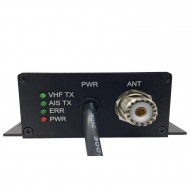









- Stock:
- Model: Glomex RA111AIS with choice of RG8X cable length
- Weight: 1.00kg
- Dimensions: 45.00cm x 35.00cm x 16.00cm
Available Options
Description
These aerials have become a top selling line for us. This is probably because they are the perfect solution for a small and robust dedicated AIS aerial. Customers like the fact that they can have the cable made up to their specified length using a better quality low loss cable than these aerials come supplied with as standard and that we can leave one end connector off for an easier install through bulkheads and small holes. The stainless bracket is universal fitting and can be surface or rail mounted.
The importance of using the right cable
RG8X extra quality low loss cable
We don't supply RG58, the cable normally supplied with these aerials, as it has significant losses over length. We use RG8X which is a good compromise between RG58 and RG213 type cables. Whilst RG58 is suitable for short runs of co-axial cable, at 10 metres the losses may be noticeable. This is inevitable as all cables exhibit loss over length, so ideally a cable should be chosen with the least losses, but here there is a trade off as less loss will mean a cable with a thicker inner core, a thicker dielectric insulation and a more dense outer braid. This all adds up to a cable that becomes very expensive and also unwieldy and inflexible. RG213 is a good example - this is the cable that Radio Hams use - it has significantly lower loss over distance but it is expensive and when installing it is very hard to get around corners and into tight recesses as the cable is so inflexible. RG8X (or mini8 as it is also known) is a good compromise, a better cable than budget RG58, it has a thicker inner core, a thicker dielectric insulate and a much denser outer braid (see image) yet it is very flexible and is only 2mm, thicker than RG58 (RG58 is 5mm, RG8X 6.5 to 7mm). If you want the best low loss cable then go for RG213 or other similar specification cables but your installation is going to be very difficult and expensive - it all comes down to being a sensible compromise.To make your installation easier if running cable through a bulkhead etc: If you would like one end left prepared but un-terminated for ease of cable installation through a bulkhead, choose your cable length and 1 PL259 connector fitted from the options list in the buy options. We will make up your cable with one PL259 connected and prepare the other end of the cable for fitting. All you need to do after installing the cable is to screw the 2nd PL259 onto the prepared cable end and solder the tip (very important that it is soldered) - a length of low melting point solder is included in the aerial kit for this purpose.
If you don't need this option select 2 PL259 connectors fitted from the list.
Glomex RA111AIS TECHNICAL SPECIFICATIONS
| FREQUENCY RANGE | 161,975 - 162,025 MHz |
| GAIN AVERAGE | 1 dB |
| IMPEDANCE | 50 ohms |
| POLARIZATION | Vertical |
| SWR | ≤ 1,2 at 162 MHz |
| MAX INPUT POWER | 50 W |
| DC GROUND | No |
| ANTENNA LENGHT | 140mm/5'' |
| ANTENNA WEIGHT | 220g/7,76oz |
| TERMINATION | SO239 for PL259 male connector |
Just a note regarding gain of an aerial: An aerial cannot amplify the RF signal in the same way that an audio amplifier will make a small sound much larger. Gain in an aerial refers to how directional it is. An aerial can be made to be more or less directional and if you know where your signal is coming from then a very high gain aerial (directional) pointed in that direction will be the best choice but it will be very much less efficient in other directions. Where a signal may come from any direction it follows that low gain aerial (less directional) aerial will be better. As an example of how this works in reality: your TV aerial will be very high gain as it points to a specific TV transmitter that doesn't move whereas your AIS aerial must receive signals from all directions so will be low gain. For marine band VHF and AIS aerials we need to receive equally well through 360 degrees and so should be low gain, 3db or less. The RA111AIS has a gain of 1dB which is excellent as 0dB is considered theoretical and probably unachievable in practice.
There are lots of explanations for aerial/antenna gain on the internet and some get very complicated but the button below will open a link with quite a good explanation for anyone interested.
Antenna gain (antenna-theory.com)










